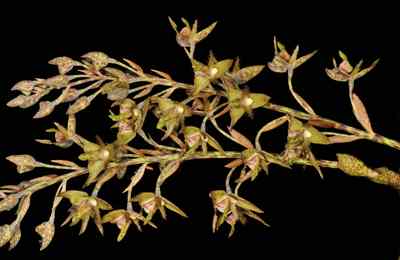The Plant
Terrestrial. Pseudo-bulbs crowded, ovoid, arranged very close to each other, attached to a stout rhizome with many thick long roots; bulbs brownish and coriaceous during flowering. Leafs oblong, obtuse, 7 to 12 cm long and 1.5 to 2 cm in width, emarginate, narrowed to both ends, the base into a long petiole of about 4 to 7 cm long. Flowers in slightly decurved peduncles, arising from the base of withered bulbs, pendulous, arranged laxly. Peduncle with two erect, large, spathulate bracts at its base.
The Flower
Flowers 12 to 20; 2 to 2.25 m across, peduncle with two large spathulate, erect bracts at its base. Sepals unequal, dorsal elliptic, acute, erect; lateral pair broadly triangular, sub-acute, the lower margin undulate and slightly bent upward, seven veined. Petals smaller than the dorsal sepal, narrowly triangular, fimbriate, spreading, three to five veined. Lip as long as the petals, attached with a large curved claw at its base, side lobes erect, apical lobe tongue-shaped, with a deep partition from the base to almost middle. Floral bracts half to one-third size of the curved pedicel, attached to its upper side, lanceolate with broad base.
Flower, peduncle and its basal bracts are of a greenish base with purplish brown streaks and dots through out. Sepals pale green with numerous purplish brown dots to its apex. Petals of the same shade as that of the sepals but with broader purplish dots on the margins, fimbria bright green with purple markings. Lip with a darker shade than that of sepals and petals at the apex and turning paler to the base, its apical lobe with several large irregular brownish spots. The outer surface of the flower with pale green shade with numerous unequal brown dots and streaks. Floral bracts pale brown with darker irregular markings.

The Pursuit
This species is very rarely found from the region. I had studied this species in detail from the referral book of King and Pantling. Its pseudo bulbs are arranged very closely and has a stout rhizome with thick roots, with bulbs coriaceous in texture – were the features I had chosen to locate this plant. As most of the trees will be devoid of any monsoon climbers in the winter months, it was very easy to search for small plants like this species. One afternoon, my assistant and me were in a thick-forested area of a wildlife sanctuary at an altitude of around 4800 ft. We were there looking for few plants blooming in the winter months including this species.
My assistant, who belongs to an indigenous community of the region, has the knack of imitating the sound of birds. He always imitates the sound of some or other birds to bring them out from hiding. Instead of looking for orchids he then observes those birds through my binoculars and describes their colours, shapes etc to me. As it interrupts my purpose of visit, I always discouraged him from this sort of distractions. The same afternoon, he was making the sound of a particular bird, he had observed several times there. His sound made a male bird of that species come out from its hiding and it started reciprocating the calls made by him. His curiosity made him observe the bird through my binoculars. His descriptions of bright red feathers, yellow beak provoked me to observe the bird through the binocular. I was panning the binocular to locate the bird and my view got stuck on a bunch of orchid plants around 40 to 50 ft high on a tree next to the bird. The view from that position was good to observe the bird but not the orchids. So I moved ahead to the other side of the tree for a good look, which disturbed the bird, and it flew away making my assistant bit unhappy. He also came to help me to the other side of the tree and to our surprise it was this species, that also with several peduncle in buds. My assistant was a very good climber and whenever he is with me I always felt comfortable. We both were up the tree and studied the plant and decided to make another visit after 6 days.
On the sixth day, we were again there. My assistant making those bird cries again, but the bird never turned up on that day. At the top of the tree, we found only a few of them in bloom and decided to come back after 2 days. On the third visit my assistant was unable to be with me and I went all-alone to the location. Trekking those deep forests and climbing those heights without any assistance, also with cameras and accessories was very difficult, but the curiosity of having a new specimen documented makes the trek as well as the climb go on. On that day except one peduncle rest everything was in bloom and I produced this beautiful photograph of the species.
Moral: Respect the qualities and skills of everybody around.
Reference:
Acrochaene punctata Lindl., Page no 153 of The Orchids of the Sikkim-Himalayas by Sir. George King and Robert Pantling (1898).